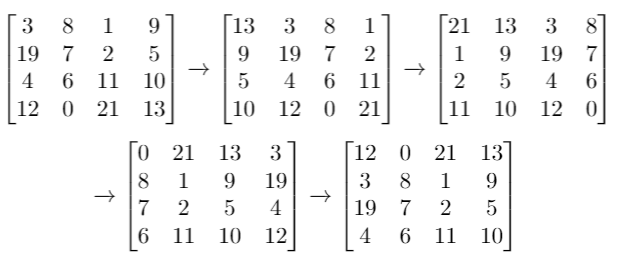Package g1201_1300.s1260_shift_2d_grid
Class Solution
java.lang.Object
g1201_1300.s1260_shift_2d_grid.Solution
1260 - Shift 2D Grid\.
Easy
Given a 2D `grid` of size `m x n` and an integer `k`. You need to shift the `grid` `k` times.
In one shift operation:
* Element at `grid[i][j]` moves to `grid[i][j + 1]`.
* Element at `grid[i][n - 1]` moves to `grid[i + 1][0]`.
* Element at `grid[m - 1][n - 1]` moves to `grid[0][0]`.
Return the _2D grid_ after applying shift operation `k` times.
**Example 1:**

**Input:** `grid` = \[\[1,2,3],[4,5,6],[7,8,9]], k = 1
**Output:** [[9,1,2],[3,4,5],[6,7,8]]
**Example 2:**

**Input:** `grid` = \[\[3,8,1,9],[19,7,2,5],[4,6,11,10],[12,0,21,13]], k = 4
**Output:** [[12,0,21,13],[3,8,1,9],[19,7,2,5],[4,6,11,10]]
**Example 3:**
**Input:** `grid` = \[\[1,2,3],[4,5,6],[7,8,9]], k = 9
**Output:** [[1,2,3],[4,5,6],[7,8,9]]
**Constraints:**
* `m == grid.length`
* `n == grid[i].length`
* `1 <= m <= 50`
* `1 <= n <= 50`
* `-1000 <= grid[i][j] <= 1000`
* `0 <= k <= 100`
-
Constructor Summary
Constructors -
Method Summary
-
Constructor Details
-
Solution
public Solution()
-
-
Method Details
-
shiftGrid
-